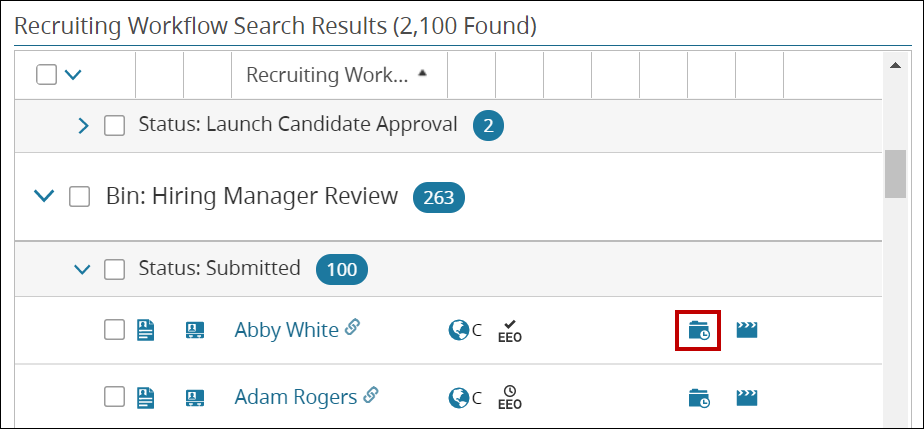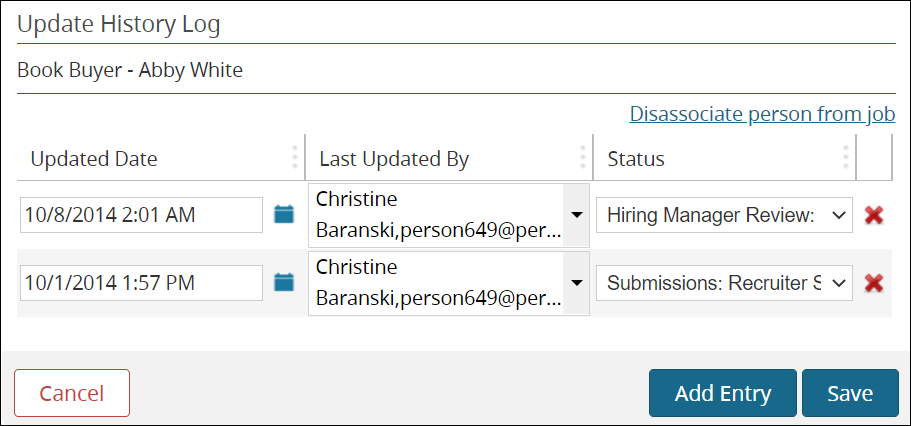Feature Highlight: Recruiting Workflow History Reports
Problem
You want to create a report that shows when candidates were placed in specific statuses and by whom over a given period of time to ensure your recruiting team is following the correct workflow within the system. How can you build a report that tracks this type of recruiter activity?
Solution
Recruiter activity reports and reports that detail candidates' historical statuses (called recruiting workflow history reports) are created using some of the powerful filters and columns available in Recruiting Workflow searches in iCIMS Applicant Tracking (ATS). A recruiting workflow history report can also be used to address any situation in which the count of candidates for a specific status is needed for a given time period.
Implementing recruiting workflow history reports in your system can seem tricky without knowing how the required filters and columns work. This article will first discuss how this solution works within the system and identify all of the necessary components before finally demonstrating what a configured template should look like.
Recruiting Workflow History Reports: Introduction
You might recall that one of the default output columns in a Recruiting Workflow search is the Recruiting Workflow History icon, highlighted in the image below.

Clicking the Recruiting Workflow History icon presents the user with a popup that details each status a candidate has been moved through for that particular recruiting workflow, as shown below.

A recruiting workflow history report lets you capture information from this log for multiple candidates (and multiple recruiting workflows), allowing you to report on how many of these entries exist for a given time period. Recruiting workflow history reports function by using specialized filters and columns that allow you to pull every single one of these entries into a Recruiting Workflow search, enabling you to view the full path individuals take in your organization's recruiting workflow.
It's important to note that recruiting workflow history searches, just like the history log shown above, consist of multiple rows for the same individual. This means a recruiting workflow history search will return multiple rows for the same person that may seem to contain the same information. However, when the appropriate columns are used, each one of those rows contains unique workflow information, including the status, updated date, and updated by name for each applicable workflow status change.
Recruiting Workflow History Reports: Filters and Columns
To proceed, it's important to understand the filters and columns used to create a recruiting workflow history report. Most of these filters and columns can be found in the Reporting & Advanced Options - General > Recruiting Workflow History section of the filter/column picker popup, as shown below.

Filters
- History Updated Date - This refers to the time stamp when a candidate was moved into a status. When used as a filter, History Updated Date returns all candidates that had a status change during the time frame specified.
- For example, if this filter is set to History Updated Date is This Month the search will return every status that individuals were placed into during the current month. Often a person is moved into multiple statuses within a month, so the search will return multiple rows for the same person, with one row representing each unique status they were placed into.
- History - Associated Submittal - This filter is used when you want to report on the history of applicants attached to a specific job or set of jobs. This filter lets you perform searches for a specific job, using system ID, or a set of jobs that share a common criteria, such as department or hiring manager.
- For example, by using a job's department as the Associated Submittal criteria, you would be able to report on every status that applicants attached to jobs within the selected department were moved into.
- History Updated By - This filter is used to focus on a specific user (typically a recruiter) that physically moved candidates from one status to another.
- For example, you can use this to specifically report on an individual recruiter or a team of recruiters. History Updated By - System ID can be used to show all candidates and corresponding status changes that were made by a single, specified user.
- Self-Nominations - This filter isn't found under Recruiting Workflow History like those mentioned above; instead it's found under Reporting & Advanced Options - Advanced > Self-Nominations. It's best practice to set this filter to Self-Nominations is Remove Self-Nominations, as that will remove all entries where someone moved themselves to a new status, such as when a candidate applied to or withdrew from a job. This is typically useful for activity reports since no action was taken by a recruiter or other system user.
Columns
While there are quite a few columns to choose from, the most valuable are outlined below. If any of the below columns seem confusing, don't worry! The example search linked in the Using These Features section of this article will show these columns in action to help paint the full picture.
- History Recruiting Workflow Status - This column is crucial when using any of the filters above; it will display a unique row for each status that a candidate was moved into. Again, keep in mind the image of the history log, which showed when and what statuses a candidate was in previously.
- History Updated Date - This column displays the time at which the candidate was moved into each historical status. This column should be used in tandem with the History Recruiting Workflow Status column.
- History Updated By > Contact Tab > Full Name: First Last - This column is used to display the name of the individual that moved the candidate into each historical status. For recruiter activity reports, this is an essential column.
Using These Features
For a full example of using the filters and columns described in this article to run a Recruiter Activity Report in iCIMS ATS, see
Recruiting Workflow Searches: Recruiter Activity Report.




